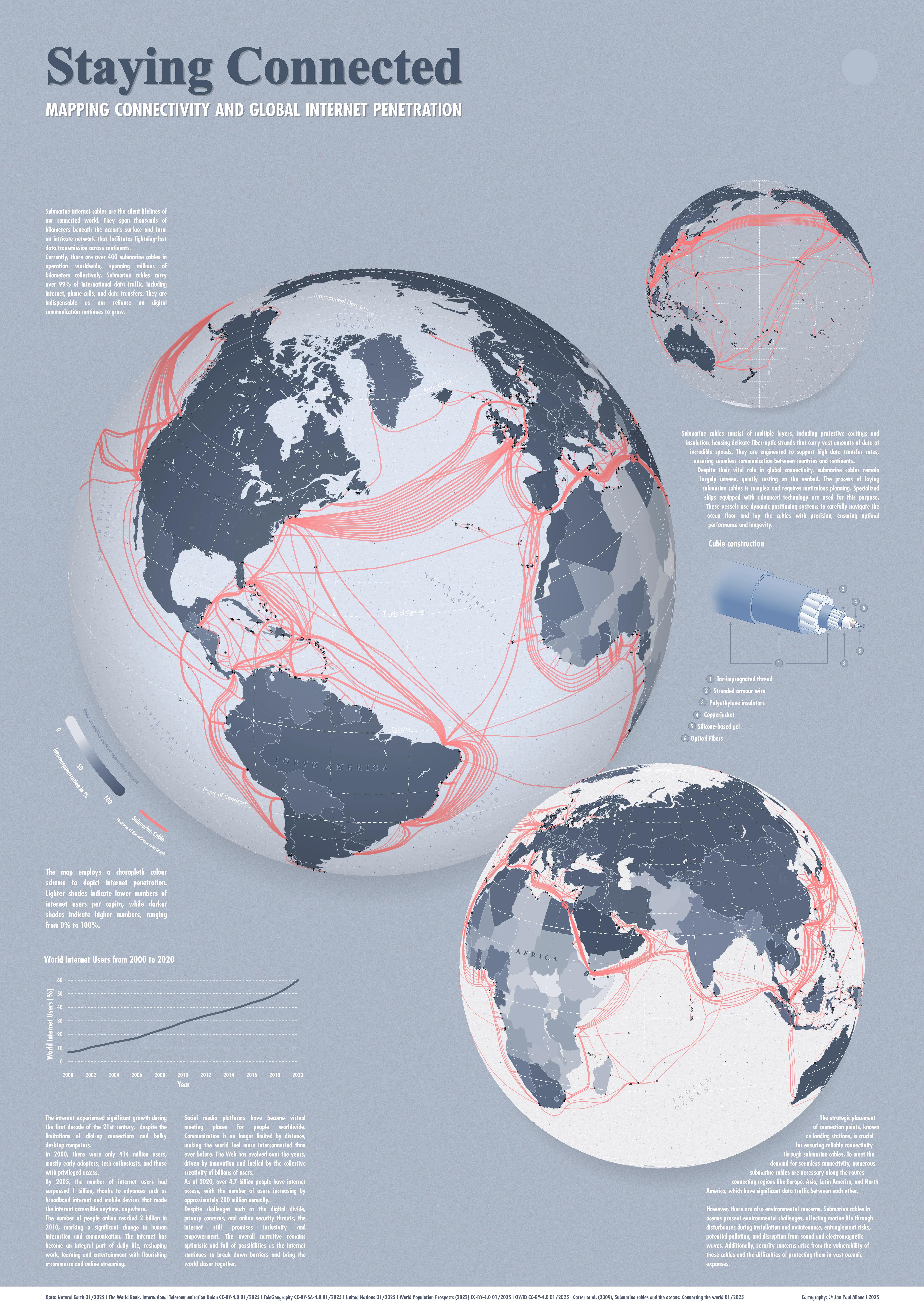Global Underwater Internet Cables Map


Alex Cartwright
Senior Cartographer & GIS Specialist
Alex Cartwright is a renowned cartographer and geographic information systems specialist with over 15 years of experience in spatial analysis and data...
Geographic Analysis
What This Map Shows
The map by geospatial analyst Jan Paul Miene provides a detailed visualization of the global network of submarine internet cables that connect countries across the world. These cables are critical infrastructure for enabling internet access, facilitating communication, and supporting global commerce. The map illustrates not only the general pathways of these undersea cables but also highlights internet penetration rates by country, revealing the disparities in connectivity across the globe.
Deep Dive into Submarine Internet Cables
Submarine internet cables are the backbone of the world’s internet infrastructure. Did you know that approximately 99% of intercontinental data traffic travels through these cables? This extensive network, stretching for hundreds of thousands of kilometers across ocean floors, enables everything from streaming services to international banking transactions.
What’s fascinating is how these cables are laid. They are typically constructed from solid glass fiber wrapped in layers of protective material to withstand the harsh conditions of the ocean. The process of laying cables involves specialized ships that can accurately place these cables on the ocean floor, often using advanced technology to avoid underwater hazards such as shipwrecks and natural formations.
The global submarine cable network consists of various cables that serve different regions, with some connecting entire continents while others link specific countries. For instance, the Transatlantic cables connect North America to Europe, while the Asia-Pacific region is served by an intricate web of cables that link countries like Japan, Australia, and the Philippines.
Internet penetration varies widely across different nations and regions, which is clearly reflected in the map. For example, countries like the United States and those in Western Europe enjoy high levels of connectivity, with internet penetration rates exceeding 90%. In contrast, many countries in Africa and parts of Asia still grapple with low connectivity levels, which impact economic growth, education, and access to information.
Regional Analysis
When we look at specific regions on the map, the disparities in internet access become even clearer. In North America, the presence of multiple submarine cables ensures redundancy and high-speed connectivity, making it one of the most connected regions in the world. According to recent data, the United States has one of the highest internet penetration rates globally, with over 90% of its population having access.
Conversely, in regions like Sub-Saharan Africa, the situation is markedly different. While countries like South Africa and Kenya have made significant strides in improving their internet infrastructure, much of the region still struggles with limited access. The map reflects this by showing fewer submarine cables in these areas, which correlates with lower internet penetration rates. For example, countries like Chad and the Central African Republic have reported penetration rates below 10%.
Interestingly, the Southeast Asian region presents a unique case. Countries like Singapore and Malaysia are well-connected due to their strategic geographical locations and investments in internet infrastructure. However, neighboring countries such as Myanmar and Laos still face challenges, indicating a need for continued investment in submarine cable technology and public-private partnerships to enhance connectivity.
Significance and Impact
Understanding the global network of submarine internet cables is crucial, especially in today’s digital age. As we increasingly rely on internet connectivity for everyday activities, economic transactions, and global communication, the implications of this map extend far beyond mere geography.
With the ongoing expansion of the internet into underserved regions, there is a significant opportunity for economic development. Countries that improve their internet infrastructure can enhance educational resources, facilitate e-commerce, and foster global collaboration. However, it is essential to address the digital divide and ensure that all nations have equitable access to this vital resource.
Looking ahead, experts predict that investments in submarine cables will continue to grow, especially with the increasing demand for data driven by cloud computing, streaming services, and the Internet of Things (IoT). The future of global connectivity hinges on the ability to lay these cables in a sustainable manner that considers both environmental impacts and the communities they serve.
In conclusion, the map of underwater internet cables by Jan Paul Miene is not just a representation of cables on a map; it's a vital depiction of how the world remains interconnected through technology. As we move forward, understanding and improving this infrastructure will be crucial for global progress and equity in internet access.
Visualization Details
- Published
- October 3, 2025
- Views
- 46
Comments
Loading comments...